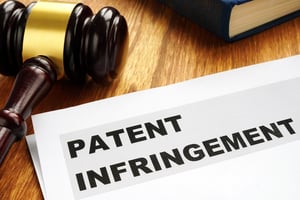Spotlight on Patent Infringement: Recent Federal Circuit Case Offers Guidance on the EMVR
 In general, a patent holder seeking infringement damages must apportion profits or royalties between the patented feature and any unpatented features of the infringing product.
In general, a patent holder seeking infringement damages must apportion profits or royalties between the patented feature and any unpatented features of the infringing product.
Apportionment ensures that damages reflect the value attributable to the infringing features without allowing the patent holder to benefit unfairly from the value of the product’s unpatented features.
There’s an important exception to apportionment known as the “entire market value rule” (EMVR). It allows a patent holder to recover damages based on the full value of the infringing product, even if it contains multiple features, provided the patent holder can establish that the patented feature constitutes the basis for consumer demand for the product.
In other words, if the patented feature drives demand for the product, the value attributable to that feature is the product’s entire value.
The U.S. Court of Appeals for the Federal Circuit has exclusive jurisdiction over patent appeals. In Power Integrations, the court provided guidance on what a patent holder must prove to take advantage of the EMVR and avoid apportionment.
Power Struggle
Both parties manufactured power supply controller chips that are used to regulate the flow of power in chargers and other devices. In 2009, Power Integrations filed a lawsuit against a competitor, alleging patent infringement. The main patent at issue covers switching regulators used in the chips that enable power supplies to run more quietly and efficiently.
After a 16-day jury trial in early 2014, the jury found that the defendant had indeed infringed several of Power Integrations’ patents and awarded $105 million in reasonable royalty damages. Six months later, while the case was still pending in the federal district court, the Federal Circuit decided a similar case, VirnetX, that had important implications for apportionment cases.
Previously, in cases involving products with both patented and unpatented features, some courts allowed apportionment based on the “smallest salable patent-practicing unit.” But in VirnetX, the Federal Circuit found that practice insufficient to satisfy a patent holder’s apportionment obligation. Because Power Integrations didn’t apportion royalties beyond the smallest salable unit (and had disclaimed reliance on the EMVR), the district court ordered a new trial.
In the second trial, held in late 2015, the court granted a Daubert motion excluding Power Integrations’ expert testimony on apportionment but allowed its expert to testify based on the EMVR. This time, the jury awarded Power Integrations nearly $140 million in damages, relying on the infringing products’ entire market value as the royalty base.
Appeals Court Ruling
The EMVR is available only when the patented feature drives consumer demand for the infringing product. On appeal, the Federal Circuit found that the evidence Power Integrations presented was insufficient as a matter of law to invoke the EMVR, vacating the judgment and remanding the case to the district court.
The court ruled that the EMVR may be appropriate if the patented feature accounts for virtually all the product’s value. This may be the case if, for example, the product’s other features are generic or conventional, and thus “of little distinguishing character.”
Power Integrations offered the following evidence to prove that the patented feature was essential:
- The patented feature enabled the products to meet the requirements of the federal Energy Star program.
- Some customers specifically asked for the patented feature.
- Products with the patented feature outsold other products.
- The defendant’s marketing materials promoted the patented feature.
The parties agreed that the infringing products contained other valuable features. But the court found that Power Integrations had “presented no evidence about the effect of those features on consumer demand or the extent to which those features were responsible for the products’ value.”
The court explained that it isn’t enough to demonstrate that the patented feature is valuable or important to the infringing product. Rather, the EMVR is available only “when the patented feature is the sole driver of customer demand or substantially creates the value of the component parts.”
Setting a High Bar
Power Integrations shows that the EMVR is a strictly limited exception to the apportionment requirement. According to the Federal Circuit, when an accused infringer presents evidence that its product has valuable features in addition to the patented feature, the patent holder must show that those other features are irrelevant to consumer choice in order to invoke the EMVR.








